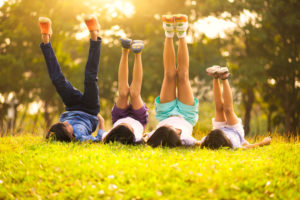
Natural playgrounds are places where children can play with wood, mud, sand, water and other natural elements. Natural play spaces engage children in play using the environment rather than manufactured equipment. These are becoming a popular choice for playground designers, communities and families.
“Access to active play in nature and outdoors-with its risks-is essential for healthy child development. We recommend increasing children’s opportunities for self-directed play outdoors in all settings-at home, at school, in child care, the community and nature.” – Council of Chief Medical Officers of Health, 2015, Canada
What are the benefits of natural play spaces?
Natural play spaces let children:
- Explore nature and natural materials
- Use their imaginations
- Be creative
- Choose how they want to play
- Socialize with other children
Are natural playgrounds safer than traditional playgrounds?
Any play space may have some risks. Natural playgrounds are no exception. Sometimes, risks are reduced by the design. For example, running a slide down a hill removes the risk of falling. Using timber, logs and rocks can let children climb and explore but reduce the distance that a child could fall.
Whether you are bringing your child to a nature playground or designing one for your back yard, consider:
- Fall height – A child can fall when climbing on play structures, rocks or trees. Parents need to consider about how far a child could fall. Children who are 5 years of age or less should not climb higher than 1.5 metres (5 feet)
- Surfacing – There should be impact absorbing material, such as mulch, pea gravel or rubber, under and around play equipment and natural play elements where children could fall from
- The play area is free of spaces where heads could get trapped, and
- Items such as boulders and logs are free of sharp edges and are stable and secure.
Want to learn more about natural play spaces?
- A Parent’s Guide to Nature Play describes the benefits of nature play. It has lots of ideas for creating a natural play space in your backyard and for outdoor play.
- Children and Nature Network has toolkits for families and research summaries of benefits of play and learning in nature.
- Canadian Parks Council Nature Playbook and Connecting Canadians with Nature are produced by the Canadian Parks Council.
- Outside Play in an online tool that helps parents gain confidence in allowing their children to take risks and engage in more outdoor play.
- The National Wildlife Federation (U.S.) has a good guide for Green Hour recommends that parents give their kids a “Green Hour” every day, in a garden, backyard or neighbourhood park.
Looking for a natural play space to take your child to?
Some communities offer natural playgrounds. Others are adding more natural elements to existing playgrounds or combine natural and man-made play features.
City of Winnipeg Parks and Open Spaces has information on outdoor activities in Winnipeg and an interactive city map that shows natural parks, playgrounds and open spaces.
